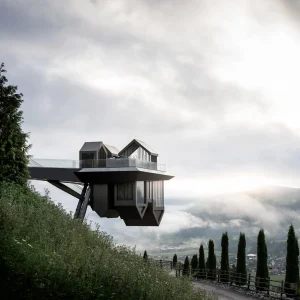Link About It: This Week’s Picks
Prompting AI art, low-carbon crypto, Patagonia’s environmental efforts and more

Making a Lithium-Ion Battery Alternative Out of Crab Exoskeletons
 Products powered by lithium-ion batteries (like electric vehicles) are in high-demand, but sourcing and mining the element requires unsustainable amounts of water and energy. On top of that, it’s a scarce resource and acquiring it can be dangerous. To find an alternative, engineers from the University of Maryland created a battery using crabs whose exoskeletons are rich in useful chemicals like chitin, a natural polymer used for tissue engineering and biodegradable plastic. Using discarded crab and other crustacean shells (of which there are six to eight million tons worldwide), the engineers extracted chitosan (a derivative of chitin that works well with water) to create a semi-permeable membrane that keeps oppositely charged electrodes apart. This process helps bypass some of the irregularities formed when using zinc-based batteries, enabling theirs to operate much longer. The crab-based batteries also decompose much quicker (in only five months). Learn more about how these crustaceans could offer a sustainable alternative to lithium at Popular Mechanics.
Products powered by lithium-ion batteries (like electric vehicles) are in high-demand, but sourcing and mining the element requires unsustainable amounts of water and energy. On top of that, it’s a scarce resource and acquiring it can be dangerous. To find an alternative, engineers from the University of Maryland created a battery using crabs whose exoskeletons are rich in useful chemicals like chitin, a natural polymer used for tissue engineering and biodegradable plastic. Using discarded crab and other crustacean shells (of which there are six to eight million tons worldwide), the engineers extracted chitosan (a derivative of chitin that works well with water) to create a semi-permeable membrane that keeps oppositely charged electrodes apart. This process helps bypass some of the irregularities formed when using zinc-based batteries, enabling theirs to operate much longer. The crab-based batteries also decompose much quicker (in only five months). Learn more about how these crustaceans could offer a sustainable alternative to lithium at Popular Mechanics.
Image courtesy of Hartsdayle/Pixabay
Outdoor Apparel Brand Patagonia Restructures To Combat Climate Change
 For years ethical apparel-maker Patagonia has donated one percent of its profits to environmental initiatives. Now the organization has restructured in advance of its 50th anniversary so that it can contribute roughly $100 million each year toward combatting climate change. The company was founded by Yvon Chouinard in 1973. He and his family, who worked together toward this restructuring for two years, have placed ownership of the innovative brand into a trust and formed a non-profit named the Holdfast Collective. Read more about this new model and what they hope to accomplish at Outside.
For years ethical apparel-maker Patagonia has donated one percent of its profits to environmental initiatives. Now the organization has restructured in advance of its 50th anniversary so that it can contribute roughly $100 million each year toward combatting climate change. The company was founded by Yvon Chouinard in 1973. He and his family, who worked together toward this restructuring for two years, have placed ownership of the innovative brand into a trust and formed a non-profit named the Holdfast Collective. Read more about this new model and what they hope to accomplish at Outside.
Image courtesy of Campbell Brewer
NASA Successfully Makes Oxygen on Mars
 In a remarkable development for space exploration, NASA’s MOXIE—aka Mars Oxygen In-Situ Resource Utilization Experiment—has successfully converted Martian air (which is predominately carbon dioxide) into oxygen. For now, it generates enough gas to sustain a small dog but the hope is to provide enough for humans and aid in the creation of rocket fuel. The machine is situated within the Perseverance rover and shaped like a toaster, breathing in Mars’ incredibly thin, challenging air and separating its molecules into necessary parts. “We have to be able to live off the land,” says NASA scientist Jennifer Heldmann. “This is the first time that we’ve been able to test and demonstrate the technology to do that.” It’s also not the only experiment underway; researchers are investigating making oxygen factories using plasma while others are looking into using the planet’s ice deposits. The experiments are a promising leap forward for understanding deep space. Learn more about it at The Atlantic.
In a remarkable development for space exploration, NASA’s MOXIE—aka Mars Oxygen In-Situ Resource Utilization Experiment—has successfully converted Martian air (which is predominately carbon dioxide) into oxygen. For now, it generates enough gas to sustain a small dog but the hope is to provide enough for humans and aid in the creation of rocket fuel. The machine is situated within the Perseverance rover and shaped like a toaster, breathing in Mars’ incredibly thin, challenging air and separating its molecules into necessary parts. “We have to be able to live off the land,” says NASA scientist Jennifer Heldmann. “This is the first time that we’ve been able to test and demonstrate the technology to do that.” It’s also not the only experiment underway; researchers are investigating making oxygen factories using plasma while others are looking into using the planet’s ice deposits. The experiments are a promising leap forward for understanding deep space. Learn more about it at The Atlantic.
Image courtesy of NASA/JPL-Caltech/The Atlantic
How Sheep Aid the Solar Energy Movement
 Maintaining solar farms requires routinely cutting back grass and weeds so they don’t block sunlight from the panels. Lawn mowers can’t easily maneuver between the sprawling array of packed panels—which is where sheep come in. Unlike goats, who chew on equipment, and cows, who are too large, sheep are the perfect height to get in-between panels. As such, they are currently employed at tens of thousands of acres of solar fields in the US. This has brought much-needed business to shepherds whose herds have generated millions of dollars in annual revenue from tidying up solar fields in the country. Read more about the surprisingly crucial helpers at The Wall Street Journal.
Maintaining solar farms requires routinely cutting back grass and weeds so they don’t block sunlight from the panels. Lawn mowers can’t easily maneuver between the sprawling array of packed panels—which is where sheep come in. Unlike goats, who chew on equipment, and cows, who are too large, sheep are the perfect height to get in-between panels. As such, they are currently employed at tens of thousands of acres of solar fields in the US. This has brought much-needed business to shepherds whose herds have generated millions of dollars in annual revenue from tidying up solar fields in the country. Read more about the surprisingly crucial helpers at The Wall Street Journal.
Image courtesy of Jordan Vonderhaar/The Wall Street Journal
Hotel Hubertus’ “Hub of Huts” Wellness Area Resembles an Upside-Down Alpine Village
 Network of Architecture’s wellness-focused addition to Hotel Hubertus—an Italian alpine haven with stunning panoramic views—looks much like a gravity-defying, upside-down village. Referencing reflections in water, nodding toward classic alpine architecture and supported by angled tree-like columns, the calming complex is known as the Hub of Huts. On the upward-facing side, the refuge incorporates two pools with a changing room and showers. In the inverted section, there’s a third outdoor pool along with two saunas and a foyer. Read more about the architectural wonder—and see several more stunning images—at Dezeen.
Network of Architecture’s wellness-focused addition to Hotel Hubertus—an Italian alpine haven with stunning panoramic views—looks much like a gravity-defying, upside-down village. Referencing reflections in water, nodding toward classic alpine architecture and supported by angled tree-like columns, the calming complex is known as the Hub of Huts. On the upward-facing side, the refuge incorporates two pools with a changing room and showers. In the inverted section, there’s a third outdoor pool along with two saunas and a foyer. Read more about the architectural wonder—and see several more stunning images—at Dezeen.
Image courtesy of Alex Filz
“Prompt Engineers” Can Create Better AI Art
 Midjourney and DALL-E are machine learning tools that generate images from word prompts and as tools like this become “more sophisticated, those prompts have become a craft in their own right.” So much so that platforms have started popping up wherein these text descriptions can be sold by “prompt engineers” that create them to “reliably produce a certain art style or subject on a specific AI platform.” More than putting together a few clever words, these individuals work as writers, engineers, artists and coders in order to convey “intended aesthetic” as well as “important elements for a scene, and brackets where buyers can add their own variables to tailor the content.” Find out more at The Verge, where Adi Robertson interviews PromptBase’s Justin Reckling.
Midjourney and DALL-E are machine learning tools that generate images from word prompts and as tools like this become “more sophisticated, those prompts have become a craft in their own right.” So much so that platforms have started popping up wherein these text descriptions can be sold by “prompt engineers” that create them to “reliably produce a certain art style or subject on a specific AI platform.” More than putting together a few clever words, these individuals work as writers, engineers, artists and coders in order to convey “intended aesthetic” as well as “important elements for a scene, and brackets where buyers can add their own variables to tailor the content.” Find out more at The Verge, where Adi Robertson interviews PromptBase’s Justin Reckling.
Image courtesy of The Verge
Ethereum’s “Merge” Cuts Energy Use by 99.95%
 In a move many years in development, the world’s second-largest cryptocurrency, Ethereum (ETH), merged with the Beacon Chain on 15 September. This replaced the original proof-of-work mechanism on the Mainnnet with a proof-of-stake consensus layer that ultimately reduces energy use by 99.95%. Rather than utilizing miners (whose computers use a lot of energy to record transactions to the blockchain), ETH’s value now comes from currency staked in a smart contract. More than 41,000 people viewed the live “Ethereum Mainnet Merge Viewing Party” on YouTube, and the transition was seamless. This historic upgrade means that Ethereum is now a low-carbon blockchain. Read more about the nuance of the transition—and how it affects Ethereum holders and the rest of the world—at Ars Technica.
In a move many years in development, the world’s second-largest cryptocurrency, Ethereum (ETH), merged with the Beacon Chain on 15 September. This replaced the original proof-of-work mechanism on the Mainnnet with a proof-of-stake consensus layer that ultimately reduces energy use by 99.95%. Rather than utilizing miners (whose computers use a lot of energy to record transactions to the blockchain), ETH’s value now comes from currency staked in a smart contract. More than 41,000 people viewed the live “Ethereum Mainnet Merge Viewing Party” on YouTube, and the transition was seamless. This historic upgrade means that Ethereum is now a low-carbon blockchain. Read more about the nuance of the transition—and how it affects Ethereum holders and the rest of the world—at Ars Technica.
Image courtesy of Paxful
Link About It is our filtered look at the web, shared daily in Link and on social media, and rounded up every Saturday morning. Hero image courtesy of Alex Filz












